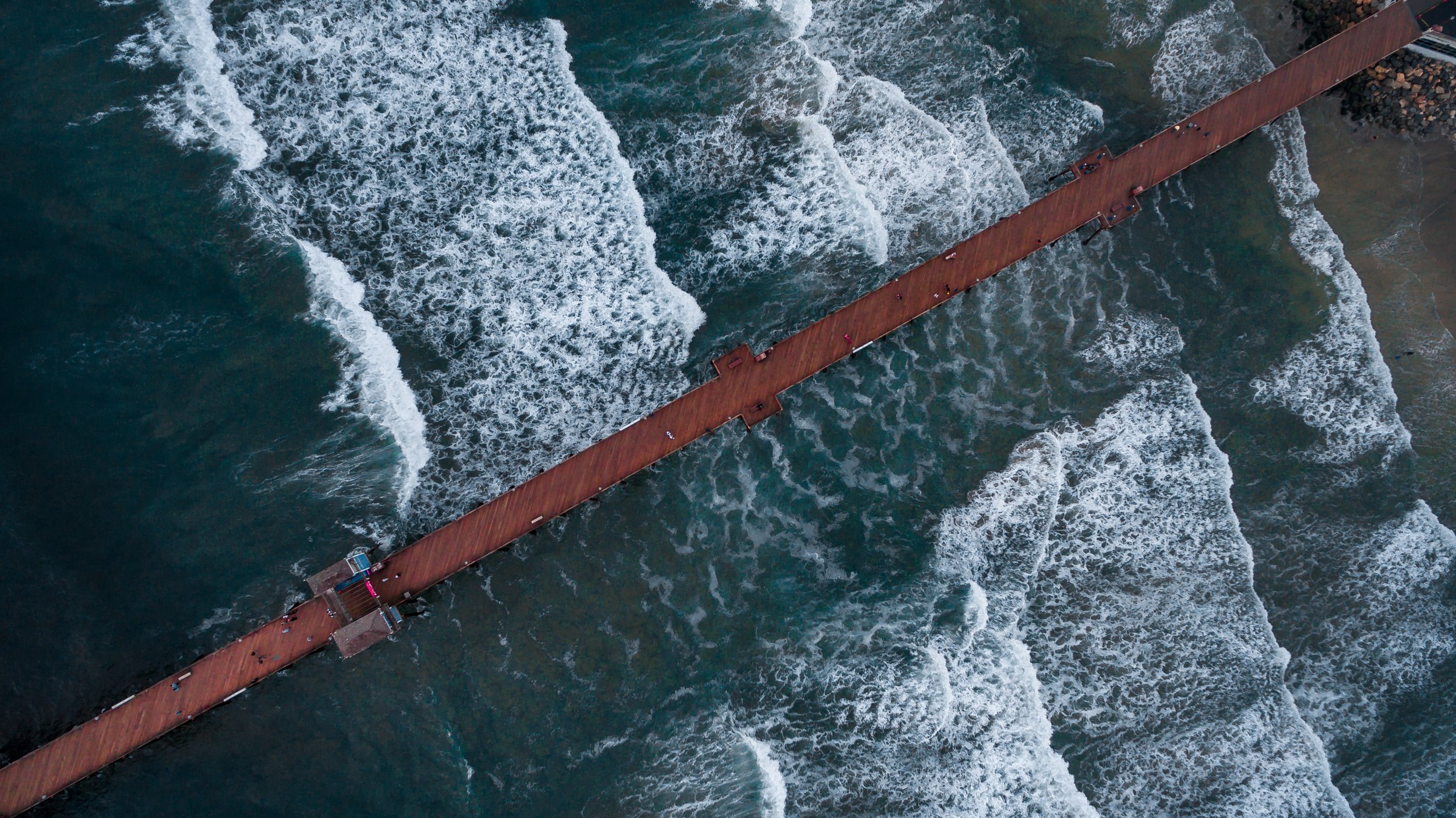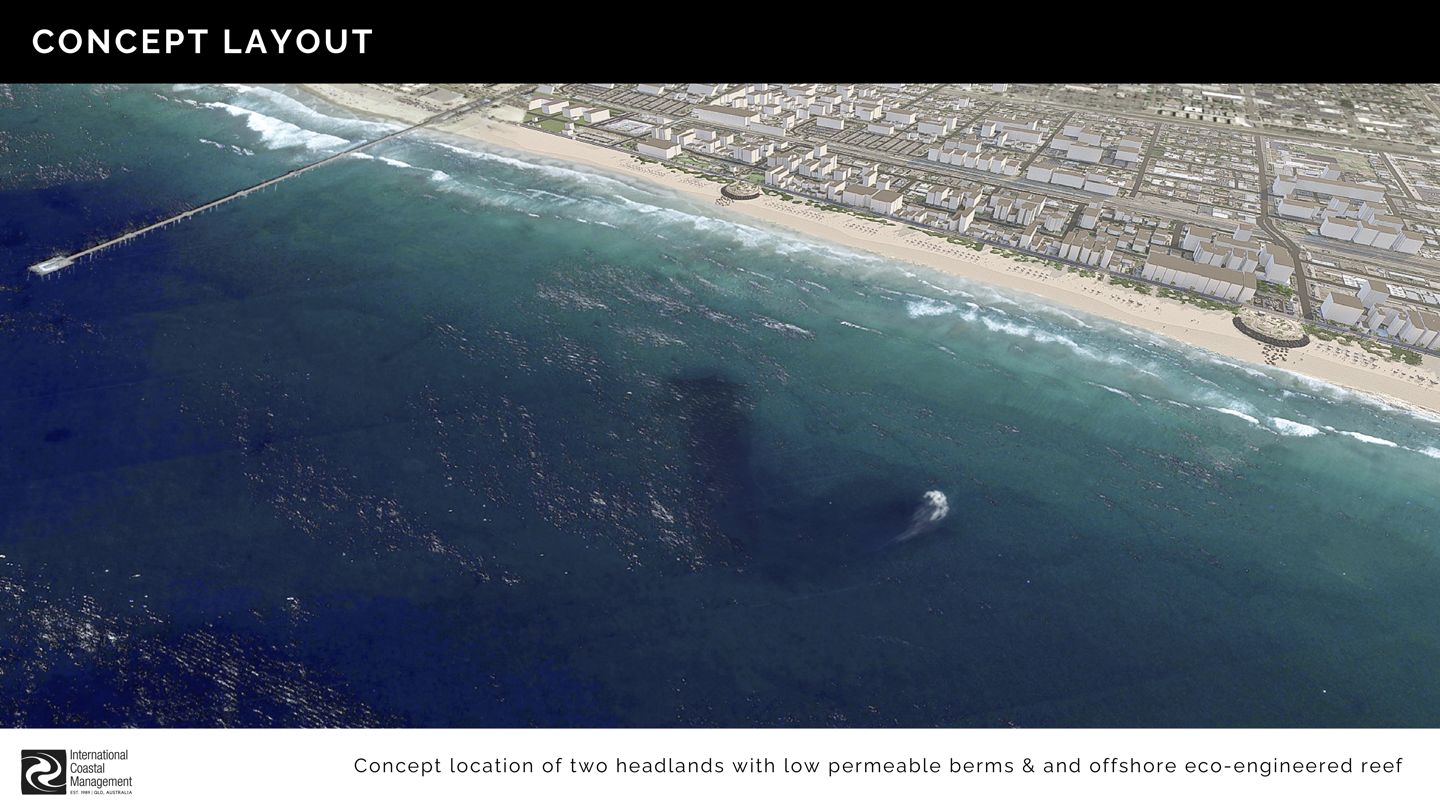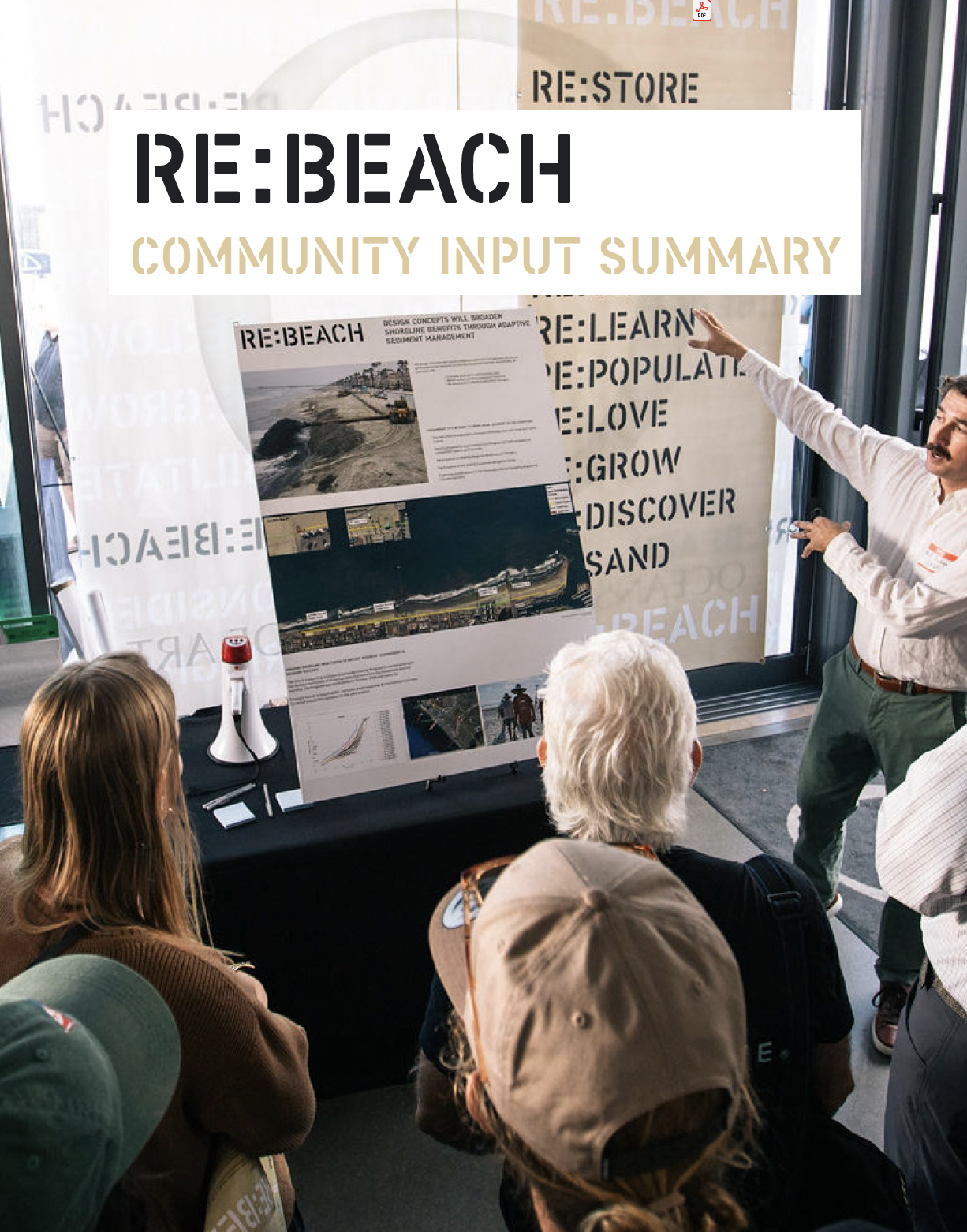
CONGRATULATIONS TO THE ICM TEAM FOR THEIR WINNING RE:BEACH DESIGN FOR OCEANSIDE
The “Living Speed Bumps” concept includes the construction of two small headlands that will aim to stabilize sand on the back beach, with an offshore artificial reef aimed at slowing down nearshore erosive forces. ICM, based in Australia’s Gold Coast, has decades of experience implementing “speed bumps” on their own coastline, bringing forward a new concept for Oceanside’s coast, but with a proven track record of success on the East Coast of Australia.
WHAT IS RE:BEACH?
RE:BEACH is the City of Oceanside’s Coastal Resilience Competition. From May - December 2023, RE:BEACH brought together 3 design teams from around the world to develop innovative sand retention pilot projects. In January 2024, Oceanside’s City Council voted to advance the ICM team to partner with GHD to advance the project concept into final engineering and permitting. In this next phase, we will continue to need public input to refine and finalize the design. Below, you can learn more about the teams, competition process, design making, and sign up to learn about ways to engage, below.
public workshops
public workshops
August 29
Oceanside City Council
300 N. Coast Highway | 4pm—7pm
The first of 3-public workshop, on August 29 the RE:BEACH project teams alongside the 3-design teams shared sand retention pilot project concepts for Oceanside. Attendees had the opportunity to engage in an “Open House”, meeting each design team, asking questions directly to designers, and providing input on the concepts. The formal presentations were recorded and can be watched back by clicking the button “EVENT RECORDING”. As well as a recording of presentations, more detail on the 3-design teams concepts can be viewed by clicking on the “EVENT SLIDES” button.
October 17
Oceanside Museum of Art
704 Pier View Way | 4pm—7pm
The second design round of the competition was about refining and tailoring solutions based on (1) feedback in the first Public Workshop and (2) increasing depth of knowledge about the particularities of sand retention in Oceanside, CA. In this round, teams have selected a 1-design concept to refine. Similar to the first Public Workshop, this workshop is NOT about ranking or selecting a design idea/concept. Instead, this session is about informing the design directions towards best design for Oceanside. We wanted to continue to bring the public into conversation with design teams, their concept and ideas, and encourage consideration around “use” and “tradeoffs” and “community fit”.
December 13
Junior Seau Beach Community Center
300 The Strand N. | 4pm—7pm
The final workshop enabled each design team to present a final, refined, sand retention pilot project for Oceanside’s beaches. This workshop signaled the final phase of the RE:BEACH design competition process and provide a final moment for public review of the concepts and designs.
Community Input Summary
RE:BEACH is a collective effort and we hear you! Throughout the design competition, public comment and feedback has been provided through online feedback forms. These responses are used by the RE:BEACH and design teams to refine pilot project concepts.
Learn more about the emergent themes by clicking the link to download the report below.
THE COMPETITION
At the core of RE:BEACH is a global design competition in search of the most innovative, multi-beneficial, and feasible solutions to preserve sandy beaches in Oceanside. A global call to action was released in spring 2023, inviting landscape architecture and engineering firms from across the world to apply to participate in RE:BEACH Oceanside. A Jury and Advisory Panel composed of local, state, and national experts was formed early on and helped in making the ultimate decision on the finalists, based on experience, proposed approach and track record of delivering innovative solutions.
In addition to the Jury, the competition is supported by a Project Team and internal City Team whose input, guidance and expertise informed the final designs produced by each team. In January 2024, these groups collectively put forward 1 winning design for the Oceanside City Council to adopt, which has allowed 1 pilot project to move into permitting.
The Project Team is composed of the City of Oceanside’s Coastal Zone Administrator, Jayme Timberlake; GHD Senior Coastal Scientists Brian Leslie and Nick Sadrpour; and Resilient Cities Catalyst Co-Founder, Sam Carter.
THE JURY
Chris Abad—Surf Resource Preservation—Director, Oceanside Boardriders Club.
Bob Ashton—Community Representative & Coastal Advocate—President/CEO, Save Oceanside Sand (SOS).
Scott Ashton—Community Representative—Chief Executive Officer, Oceanside Chamber of Commerce.
Dr. Curt Busk—Community Representative & Coastal Advocate—President, Buena Vista Audubon Society.*
Megan Cooper—Coastal Grant Funding Expert—Deputy Regional Manager, California State Coastal Conservancy.*
Councilmember Dwight Worden—Coastal City Representative—Del Mar City Council, Chair of SANDAG Shoreline Preservation Working Group.
Dr. Lesley Ewing PE—Coastal Management Expert—Former Sr. Coastal Engineer, California Coastal Commission.
Karen Green—Nearshore Marine Expert—Division Manager, Marine and Aquatic Ecosystem Resources, Tierra Data, Inc.
Dr. Arye Janoff—Coastal Management Expert—Coastal Geomorphologist, Planner & Manager with a U.S. Federal Agency.*
Dr. Charles Lester—Permitting Viability Expert—Director, Ocean and COastal Policy Center, Marine Science Institute, UC Santa Barbara.
Councilmember Joy Lyndes—Coastal City Representative—Encinitas City Council.
Dr. Dan Pondella—Nearshore Marine Expert —Professor, Biology; Director, Vantuna Research Group, Occidental College.
Ernie Prieto III—Community Representative—Local Business Owner (Ocean Sea Charter), Boat Captain and sitting member of City of Oceanside’s Harbor and Beaches Committee.
Mitch Silverstein—Coastal Advocate—Surfrider Foundation San Diego Chapter.*
Jeremy Smith—Coastal Management Expert—Coastal Engineer, California Coastal Commission.*
*indicates jurors whose role is advisory and non-voting, their ideas, input and role is purely their own expertise and does not represent the opinion of the various organizations they represent professionally.
THE
DESIGN TEAMS
SCAPE
Landscape Architecture
ABOUT:
“SCAPE is a landscape architecture and urban design practice based in New York, New Orleans, and San Francisco. We design and advocate for the ecologically restorative and socially engaged landscapes, urban environments, and natural infrastructure of the future. We do this through diverse forms of design—built landscapes, planning, visioning, and research—with the ultimate goal of connecting people to their environments.”
—with ESA and Dredge Research Collaborative (DRC)
ABOUT:
“Deltares has expertise in the policy, science and engineering disciplines that make it possible to live in densely populated and vulnerable areas in deltas, coastal zones and river basins. The combination of specialized consultancy projects and applied research puts Deltares in a unique position to address sustainability issues. To enhance our societal impact, we focus on the Sustainable Development Goals by thinking globally and acting locally.”
—with Deltares USA.
ABOUT:
“ICM is a coastal engineering firm well-known for its innovative, out-of-the-box problem solving strategies. Our innovative roots can be traced back even prior to our twenty years in the Middle East, where we worked on high-profile, crown-level projects, creating one-of-a-kind underwater structures and designing unique islands. These projects have ingrained in us a design philosophy that centers on the belief that anything is possible.”
FROM THEIR PROPOSAL:
“The Coast is Core to the Community: We understand that the beach plays a central role in the identity of Oceanside—known to some as the “hub of Southern California,” the sandy beaches and coastal waves are primary attractors for a diverse group of residents and visitors. Shore tourism, including recreational and competitive surfing, beachgoing, pier walking, and coastal trails are at the core of Oceanside, yet the environmental systems, built infrastructure, and physical materials that support the coast and beaches are eroding and threatened with sea level rise and intensifying storm events. Dry beachfront is transitioning to intertidal conditions, past engineered coastal structures are at risk of failure, and the beachfront requires significant repeat inputs of sand to respond to coastal erosion. Without new ideas or intervention, Oceanside is at risk of losing the environmental asset at the core of its economy and identity—the beach.”
Deltares & MVRDV
FROM THEIR PROPOSAL:
“The first step for an innovative approach is to re-think the way we talk about our relationship with the water and the coast. The Project team believes in the need to change the current adaptation that displays a human-centric and nature-detached perspective into a more reciprocal language such as protect each other, host and restore. We need to change our proposals from nature-based solutions to nature-based thinking.”
ICM: International Coastal Management
FROM THEIR PROPOSAL:
“Our understanding of the need for the Oceanside Sand Nourishment and Retention Pilot Project is deeply rooted in our own experience of living and working on a long stretch of highly dynamic coastline (Gold Coast, Australia) that is a hub for tourism, surfing and a quickly growing interest in conservation and sustainability. We have learned to work with nature to develop cost effective strategies that have been scalable and transferable to other sites globally.”
FAQs
-
The Design Competition Jury consists of 5-non-voting, advisory members and 10-voting members from various governmental, non-profit, and institutional sectors , reflecting community, regional and stakeholder interests in the implementation of a pilot sand retention project. The Jurors applied to participate in this role, and the Jury’s composition was established to create a diverse portfolio of expertise and perspective that is beneficial to the final pilot project outcome. After the 3rd design round in December 2023, the Jury will review the final designs, and vote to select a preferred design. The Project Team, upon approval of the Jury’s recommendation, will then draft a recommendation to be presented to the City Council for final approval in early 2024. The Project Team recommendation will be informed by multiple reviews and feedback from the competition Jury, City Team, and input from three Public Workshops.
-
One of the core criteria given to each Design Team is to ensure that regional impacts are fully mitigated; including the potential disruption of sand flow to the south. This means that designs must propose solutions that result in an equivalent or greater amount of sand flowing to its neighbors to the south. This approach is also critical to identifying a design that is congruent with the Coastal Act and the desire to coordinate on regional solutions for coastal management.
-
A Scientific Monitoring Plan was developed as part of Phase 1 (Appendix D), which will be the framework that guides the monitoring program.
Southern California beaches are dynamic as a result of varying wave approach directions and energy, which makes the flow of sand and beach change a difficult metric to measure. A robust shoreline monitoring plan has been developed to establish today’s beach conditions that can be used to compare post-project effects and identify and mitigate any potential impacts
Surfing benefits or impacts will also be assessed through a complimentary monitoring program that will follow any implemented pilot project. Based upon the selected design, a robust surf monitoring program will be developed to assist with determining benefits or impacts from a pilot project.
-
We anticipate that beach sand replenishment will continue to be an important piece of the overall strategy for the City of Oceanside and the region, but the pace at which sand is eroding off our beaches is unsustainable – as evidenced by recent sand nourishment projects and annual sand placement from Harbor dredging. Retaining some of the sand that it replenished for longer periods of time will ensure that Oceanside’s beaches are preserved and continue to provide safe access to the public. Additionally, retaining sand will make existing sand nourishment efforts that the City already partakes in more efficient and effective.
-
The Oceanside Coastal Resilience Design Competition aims to surface an innovative, multi-benefit, sand retention project for the City of Oceanside’s beaches that provides both local and regional benefits. The Jury will use specific Design Criteria to evaluate the designs. The Criteria are meant to fulfill two core objectives: (1) provide limits to the scope of design for the proposed solution; and (2) generate a set of goals that design teams, and their solutions can be measured against. There are five specific categories that the Criteria address, including 1) physical, 2) financial, 3) environmental, 4) social, and 5) regional aspects of the design.
The detailed Design Criteria can be found on the City website in the Design Brief.
-
RE:BEACH needs your input and perspective to ensure the best possible designs are developed and considered throughout the competition! We invite you to attend one or more of the Public Workshops to get updates on the Design Teams’ work, and give feedback on what you would like to see happen on Oceanside’s beaches. In addition, after each Public Workshop we will be posting updates on the designs to this website. Join our mailing list to stay updated, and follow along with RE:BEACH on Instagram @rebeachoside.
-
Once a final design has been selected and approved by the Oceanside City Council the Project Team will develop final engineering plans and environmental review and permitting for the project. These steps are anticipated to take 1-2 years after a final design is selected. Funding for implementation and construction of the project would then need to be secured. Potential construction could begin as early as 2026.
-
RE:BEACH is a stand alone process led by the City of Oceanside to design and implement a solution for Oceanside’s coast. The City and Project Team are currently coordinating with other coastal projects being planned throughout the region that will overlap in some way with RE:BEACH in an effort to find complimentary and collaborative solutions. This also includes coordination with regional jurisdictions through the San Diego Association of Governments (SANDAG)’s Shoreline Preservations Working Group (SPWG). However, these projects are led by other entities (not the City of Oceanside) and have their own schedule, goals, funding sources, and permitting requirements.
The U.S. Army Corps of Engineers Oceanside Shoreline Mitigation Study is evaluating the coastal processes along Oceanside’s beaches while investigating possible erosion mitigation actions or projects. As the study progresses it will continue to develop and evaluate potential strategies. More information on this Study is available here.
The Buena Vista Lagoon Enhancement Project is in the design phase of the project, and is currently led by SANDAG and the Buena Vista Lagoon Joint Powers Committee. The overall purpose of the Enhancement Project is to enhance the biological and hydrological functions and recreational values of Buena Vista Lagoon by addressing increased sedimentation and invasive vegetation encroachment, as well as resulting declining coastal biodiversity, degrading water quality, water circulation restriction, and increased vector concerns. More information on this Project is available here.
The SANDAG Regional Beach Sand Project (RBSP) III is the third iteration of a regional effort focused on dredging clean beach quality sand from offshore deposits and placing it on the shoreline across San Diego. Over the past year, the Shoreline Preservation Working Group (SPWG) at SANDAG has been determining next steps in pursuing a RBSP III. The first necessary step is to prepare an updated Economic Analysis and Feasibility Study for all interested coastal communities. As was done with both prior RBSPs, SANDAG has recommended that the jurisdictions fund the cost of the next step to be more competitive for state and federal grants to cover the larger engineering and construction costs. Oceanside intends to remain as an active participant in all future RBSPs or sediment management efforts. The Oceanside City Council has already signed on to support its portion of RBSP III. More information on this project is available here.
PRESS
City Council Unanimously Approves RE:BEACH Project
City of Oceanside | January 31, 2024The City Council met at a Workshop on January 31, 2024, to discuss the RE:BEACH project, and unanimously approved moving forward with the ICM proposal.
A California Beach Town is Desperate to save it’s vanishing sand
The New York Times | September 2, 2023Sea-level rise and man-made projects have left Oceanside with precious little beach space. That’s a problem if coastal life is part of your city’s identity.
Firms reveal proposals for a project to restore oceanside beach sand
The San Diego Union-Tribune | August 30, 2023Over 200 community members participated in the RE:BEACH first public workshop on August 29, 2023 where design concepts like, islands, artificial reefs, and a coastal forest are among the proposals outlined.
Oceanside Names Jury to Advise Coastal Resilience Design Competition
The San Diego Union-Tribune | May 1, 2023Today, the City of Oceanside named 15 local, state, and national experts to serve as a Jury in its upcoming Coastal Resilience Design Competition.
Sand Nourishment and Retention Pilot Project
Coast News | January 23, 2023The City plans to solicit innovative design ideas for a sand retention pilot project through a design competition process.









